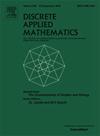The d-blocker number and d-transversal number of hexagonal systems
IF 1
3区 数学
Q3 MATHEMATICS, APPLIED
引用次数: 0
Abstract
The carbon skeleton of a benzenoid hydrocarbon is often represented by a hexagonal system with a perfect matching (or Kekulé structure). Vukičević and Trinajstić defined the anti-Kekulé number as the smallest number of edges of whose removal results in a connected graph without Kekulé structures. In general, this article investigates related parameters, the -blocker number and the -transversal number , introduced by Zenklusen et al. These quantify the minimum sizes of an edge subset whose removal reduces the matching number by , and an edge subset that contains at least edges of every maximum matching, respectively. For parallelogram, regular hexagon-shaped, and cata-condensed hexagonal systems , we derive explicit formulas for the -blocker number for all , and explicit expressions or bounds for the -transversal number . These results extend the robustness analysis of Kekulé structures and generalize the matching preclusion number (corresponding to ) in benzenoid systems.
六边形体系的d-阻挡数和d-截数
苯类烃的碳骨架通常由具有完美匹配(或kekul结构)的六方体系H来表示。vuki eviki和trinajstiki将反kekul数ak(H)定义为除去H的最小边数,得到无kekul结构的连通图。总的来说,本文研究了相关参数,即由Zenklusen等人引入的d阻断剂数βd(H)和d横截数τd(H)。它们分别量化边缘子集的最小大小,其移除将匹配数量减少d,以及包含每个最大匹配的至少d条边的边缘子集。对于平行四边形,正六边形和数据凝聚六边形系统H,我们导出了所有1≤d≤|V(H)|/2的d-阻截数βd(H)的显式公式,以及d-截数τd(H)的显式表达式或界。这些结果扩展了kekul结构的鲁棒性分析,并推广了苯系的匹配排除数(对应于d=1)。
本文章由计算机程序翻译,如有差异,请以英文原文为准。
求助全文
约1分钟内获得全文
求助全文
来源期刊

Discrete Applied Mathematics
数学-应用数学
CiteScore
2.30
自引率
9.10%
发文量
422
审稿时长
4.5 months
期刊介绍:
The aim of Discrete Applied Mathematics is to bring together research papers in different areas of algorithmic and applicable discrete mathematics as well as applications of combinatorial mathematics to informatics and various areas of science and technology. Contributions presented to the journal can be research papers, short notes, surveys, and possibly research problems. The "Communications" section will be devoted to the fastest possible publication of recent research results that are checked and recommended for publication by a member of the Editorial Board. The journal will also publish a limited number of book announcements as well as proceedings of conferences. These proceedings will be fully refereed and adhere to the normal standards of the journal.
Potential authors are advised to view the journal and the open calls-for-papers of special issues before submitting their manuscripts. Only high-quality, original work that is within the scope of the journal or the targeted special issue will be considered.
 求助内容:
求助内容: 应助结果提醒方式:
应助结果提醒方式:


